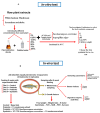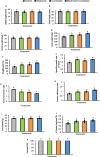Evaluation of the synbiotic effects of Saccharomyces cerevisiae and mushroom extract on the growth performance, digestive enzyme activity, and immune status of zebrafish danio rerio
- PMID: 39245724
- PMCID: PMC11382455
- DOI: 10.1186/s12866-024-03459-2
Evaluation of the synbiotic effects of Saccharomyces cerevisiae and mushroom extract on the growth performance, digestive enzyme activity, and immune status of zebrafish danio rerio
Abstract
Background: The quest for candidate probiotics and prebiotics to develop novel synbiotics for sustainable and profitable fish farming remains a major focus for various stakeholders. In this study, we examined the effects of combining two fungal probiotics, Saccharomyces cerevisiae and Aspergillus niger with extracts of Jerusalem artichoke and white button mushroom to develop a synbiotic formulation to improve the growth and health status of zebrafish (Danio rerio). An initial in vitro study determined the most effective synbiotic combination, which was then tested in a 60-day in vivo nutritional trial using zebrafish (80 ± 1.0 mg) as a model animal. Four experimental diets were prepared: a control diet (basal diet), a prebiotic diet with 100% selected mushroom extract, a probiotic diet with 107 CFU of S. cerevisiae/g of diet, and a synbiotic diet with 107 CFU of S. cerevisiae/g of diet and 100% mushroom extract. As readouts, growth performance, survival, digestive enzyme activity and innate immune responses were evaluated.
Results: In vitro results showed that the S. cerevisiae cultured in a medium containing 100% mushroom extract exhibited the maximum specific growth rate and shortest doubling time. In the in vivo test with zebrafish, feeding them with a synbiotic diet, developed with S. cerevisiae and mushroom extract, led to a significant improvement in the growth performance of zebrafish (P < 0.05). The group of zebrafish fed with the synbiotic diet showed significantly higher levels of digestive enzyme activity and immune responses compared to the control group (P < 0.05).
Conclusion: Taken together, these results indicated that the combination of S. cerevisiae and mushroom extract forms an effective synbiotic, capable of enhancing growth performance and immune response in zebrafish.
Keywords: Funal probiotics; Growth; Immunity; Natural extract; Probiotic; Zebrafish.
© 2024. The Author(s).
Conflict of interest statement
The authors declare no competing interests.
Figures









References
-
- Harmsen HJ, de Goffau MC. The human gut microbiota. Microbiota Hum body: Implications Health Disease. 2016;95–108. 10.1007/978-3-319-31248-4_7.
-
- Kuang T, He A, Lin Y, Huang X, Liu L, Zhou L. Comparative analysis of microbial communities associated with the L., gill, gut, and habitat of two filter-feeding fish. Aquac Res. 2020;18:100501. 10.1016/j.aqrep.2020.100501. 10.1016/j.aqrep.2020.100501 - DOI
MeSH terms
Substances
Grants and funding
LinkOut - more resources
Full Text Sources
Research Materials

